Tags
Related Posts
Share This
First Cut
Valerie Rangel, Santa Fe papercut artist and professor of earth science at the Santa Fe University of Art and Design, grew up in close proximity to graveyards and knives.
“Maybe this,” says Rangel, who is acutely aware of how interconnected different aspects of her life are, “is really how my interest in papercutting arose. I grew up by a graveyard, and used to cut the spines out of cacti for my mother. My brother and I would throw knives for fun. These early experiences are surely connected to my interest in making artwork by cutting paper as well as the themes that I like to show in that work.”
Papercut art is essentially paper with lines and silhouettes cut out of it to make images with positive and negative space.
Rangel started making papercut art in high school as a hobby, using an exacto knife and black paper to create silhouette images from her own sketches.
“I have always been an introvert,” she says. “My friends in high school were all Goths and rejects. Papercutting takes a lot of alone time, and it was a healthy way for me to channel some of my darker energy into something creative and positive.”
After high school, Rangel was showing some of her papercuts to the owner of the restaurant where she worked as a hostess—he thought he could help her find somebody to help her commission her artwork—when she was stopped by a customer. The man was film director and actor Lou Diamond Phillips. The two started chatting, Rangel says, “because he is also native, and an artist.” Phillips told Rangel that he wanted to buy one of her papercuts: an image of a man with his ankles and wrists bound hanging upside down from a tree over a fire. It was the first papercut Rangel had ever made. Six months later, he contacted Rangel to tell her that he had hung the piece in his LA home, and he didn’t ever want her to think that her artwork was trash.”
“These things stay with you,” says Rangel. “It was a little comment, but it’s always in the back of my mind when I am working, or struggling with my work.” When Rangel ran into Phillips by chance in a Santa Fe supermarket years later, she took it as a sign of how interconnected the different events in one’s life are.
In 1999, Rangel moved to New Mexico to study the Navajo language, Native American studies, ethics, and green environmental science at UNM.
“I was interested in studying my own heritage, history, culture and language,” says Rangel, “and this was a place where these could all come together with my interest in the natural sciences.”
In 2000, when Rangel gave birth to a son, she decided it was “time to put the knives away.” She stopped making papercuts and put her focus into finishing her degree and finding work to support a family.
However, as she began to search for jobs in her field, she was presented with a world that contradicted her personal ethics concerning social justice within environmental work.
“I couldn’t live with myself working for an environmental firm that supported fracking, or putting a dump site in an area that already had three nearby, and high cancer rates connected to the pre-existing sites.”
Rangel’s mother suggested that she start making art again and try to sell it to help support her family.
“It was at this time, when I was most focused on my degree and work, that art became important again,” says Rangel. “It made me realize that art is about a search for meaning.” With papercutting back in Rangel’s life, her different interests began to come together again. She got a job, first at the New Mexico archives, and then as a teacher at SFUAD. Yoberri, a frozen yoghurt shop in downtown Santa Fe, gave her a wall to hang her papercuts. One day, while she was standing at the Redbox in Albertsons, she ran into Lou Diamond Phillips again.
“He didn’t know who I was right away,” she says, “but I reminded him of the piece I’d sold him, and was so happy to be able to tell him that I was still making that work.”
Now Rangel focuses on the interconnectivity of the world in both her hobby (“I don’t consider myself an artist,” she says, “papercutting is my hobby.”) and her job as a teacher. In the classroom, she encourages her students to explore science from as many different angles as possible. For their final project this semester, her students will research an endangered species, write a paper on the different layers of an ecosystem that affect that organism—including human social, economic and historical factors—provide a solution, and then present their findings through some creative means, be it photography, music, theatre, film, poetry or any other expressive form.
Likewise in her papercuts, Rangel links different themes and how they impact each other.
“My papercuts are all one contiguous piece of paper,” she explains, holding up a cut of the Buddha. “When you hold it up, it all holds together. Nothing is taped or pasted. When I papercut images of the Buddha, or Jesus, or St. Francis, it is about how they are all wise fools—they were all outsiders, who worked for what they believed in—and for me, about how interconnected they are. I have come to realize that art is not just about creating something because you feel like it, it is about finding meaningful images and communicating something.”
Rangel has also found ways to touch people with her art in less abstract ways. She recently donated several papercuts to the Navajo Women’s Energy Project, whose Solar Entrepreneurs Program will hold a benefit art show this winter to raise money for installing solar panels to light hogans on Navajo reservations.






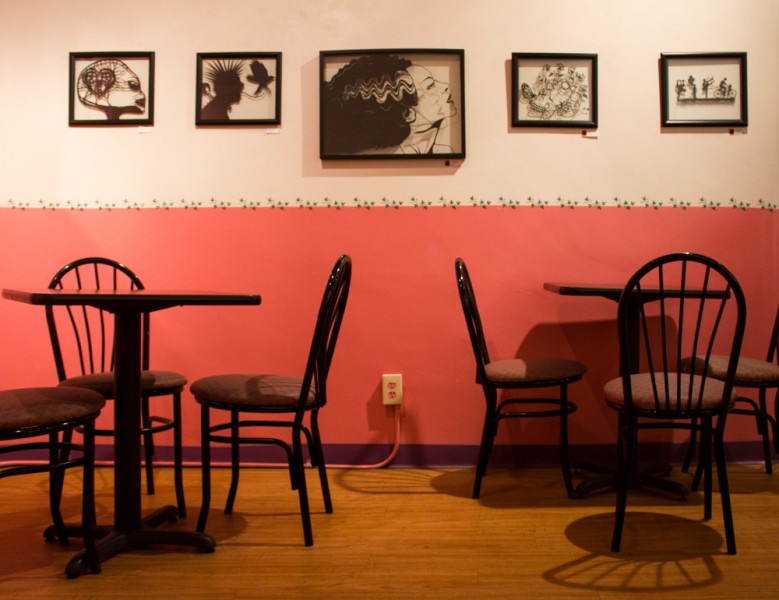
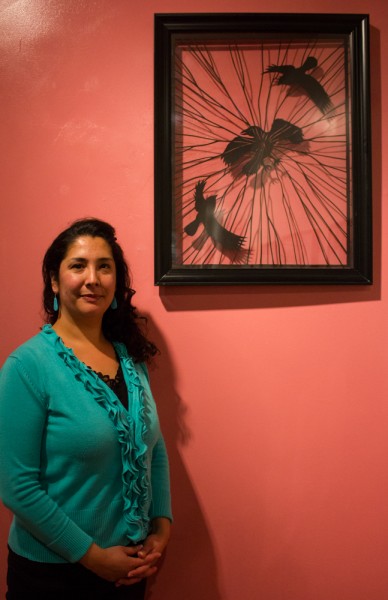
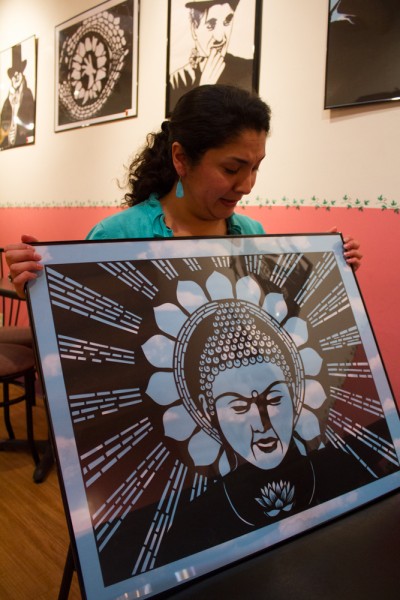
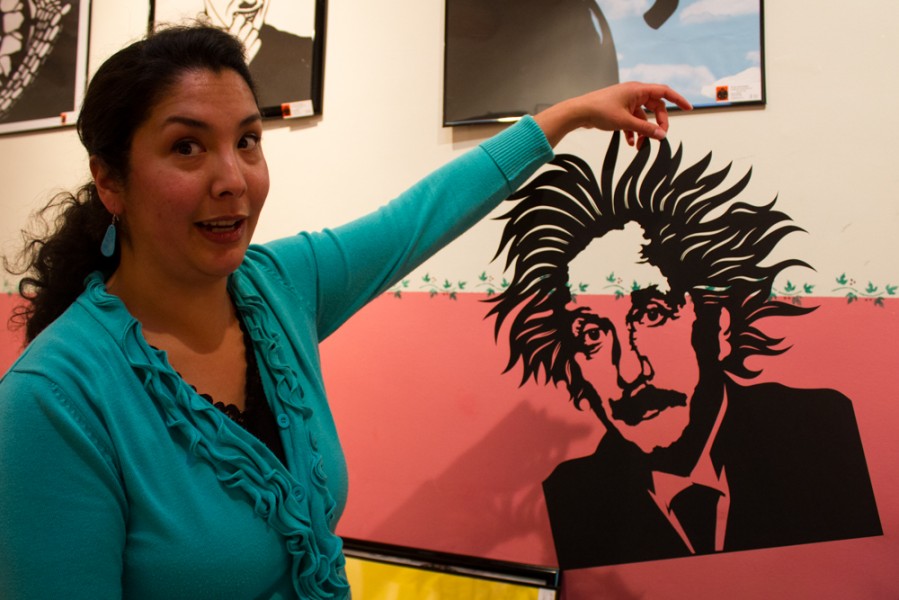
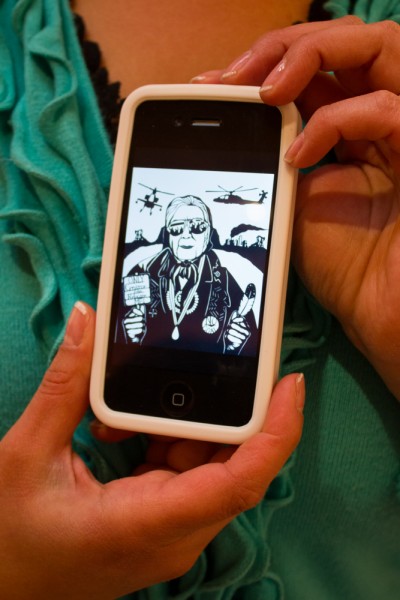
 Jackalope Magazine is the student magazine of Santa Fe University of Art and Design. Building on the interdisciplinary nature of our education, we aim to showcase the talent of our university and character of our city.
Jackalope Magazine is the student magazine of Santa Fe University of Art and Design. Building on the interdisciplinary nature of our education, we aim to showcase the talent of our university and character of our city.
Valerie your artwork is world-class! The same can’t be said of every Hollywood actor, but clearly Lou-Diamond Phillips has good taste 🙂 And apparently people on IMDB vouch for his good character as well! You should leave a comment here:
http://www.imdb.com/name/nm0001617/board/nest/43406440?p=1